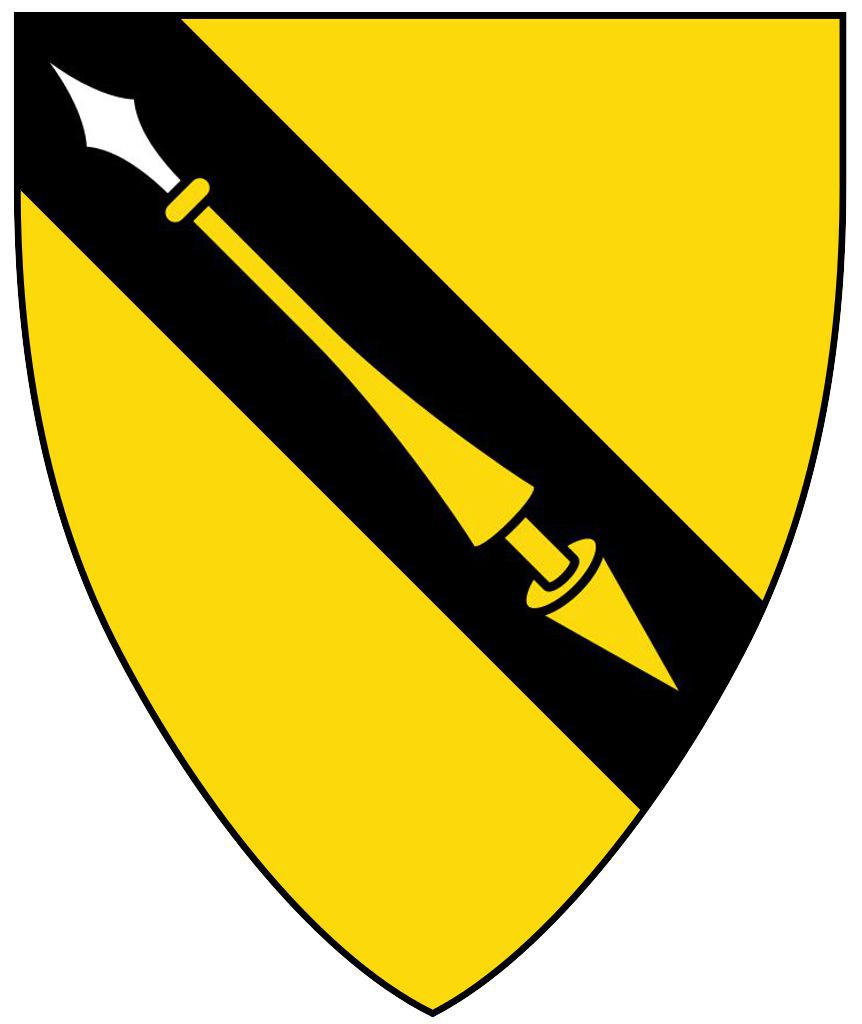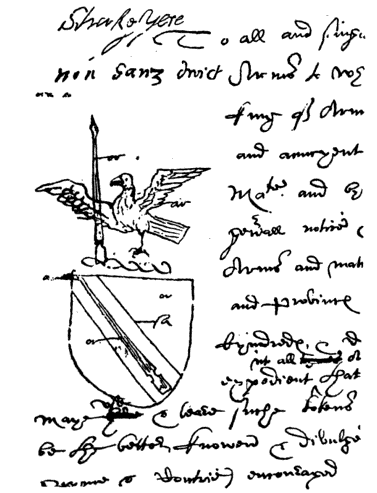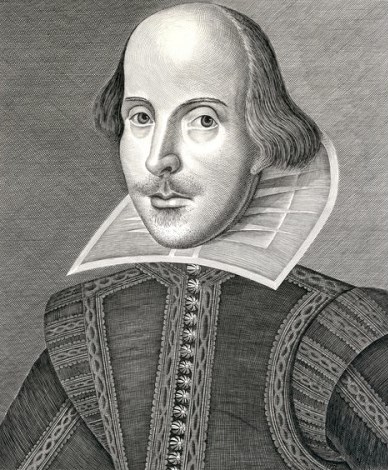 Shakespeare's Arms
Shakespeare's Arms
Before discussing the details of Shakespeare’s coat of arms, there is one strange and sad point to be observed about its timing. The two drafts of the patent awarding the coat of arms to John Shakespeare are dated 20 October 1596. William Shakespeare’s only son. Hamnet, had died in early August that year. It is a strange sequence of events that he should have acquired a coat of arms and a gentleman’s residence so soon after the death of the only child who could carry on his name. One explanation is that these projects were well under way, or at least agreed on in principle, while Hamnet still lived – and after all they would still enhance the status and marriage prospects of his daughters. We cannot be sure that Shakespeare made no further attempts to father a child in wedlock, though my own conjecture is that conjugal relations between William and Anne had ceased in the mid-1580s. Another, cynical, conjecture is that William hoped, given the discrepancy in their ages, that he would outlive Anne, and would one day be able, as a gentleman, to make a more genteel marriage, and to beget a son to carry on his name and bear his arms.
When Shakespeare approached the Heralds he, probably, already had a clear idea of the design of his coat of arms. He may even have paid a painter, perhaps his painter-colleague Richard Burbage, to do a mock-up, which was one of the ‘abuses’ of which William Smith, Rouge Dragon Pursuivant, was to complain in 1605-6. The concept of a spear on a bend could have been already in place when, or if, his father attempted to acquire a patent some twenty years before, for which the then Clarenceux Herald Robert Cooke had allegedly drawn a ‘pattern’. But the note at the end of the second draft that alludes to this suggests an assertion rather than a reference to a visible document. According to one authority on grants of arms, any man is allowed to enter a large proportion of facts concerning his own pedigree from his grandfather on his own solemn affirmation, without the formality of the production of actual documentary proofs.

Most probably Shakespeare affirmed various ‘facts’ relating to his father’s status, wealth and ancestry, and alluded to a previous application made by his father, but without producing any documentation. Many of the erasures and inconsistencies in the two drafts that survive in the College of Arms – especially Draft A -suggest oral reports and instructions beset with some vagueness and inconsistency. Essentially, I suspect, both the initiative and the shaping ideas came from the younger Shakespeare. By securing armigerous status for his father John, who was not in good health, and might die quite soon, he ensured that he could himself enjoy gentle status as a gentleman’s son. Rather as the crown descended to Henry V ‘with an easier grace’ than to his usurper father, the younger Shakespeare could hope to enjoy gentle status more comfortably through the natural process of inheritance than could his father, as the technical recipient of the patent.
It was contrary to all principles of honour that the son should bestow honour on the father, rather than the other way round. As the Fool was to say in King Lear, ‘he’s a mad yeoman, that sees his son a gentleman before him’. Nevertheless, this was in effect what happened in the Shakespeare family, with the prosperous and celebrated Lord Chamberlain’s Man securing gentle status for his obscure and well-nigh bankrupt father. Incidentally, all authorities concur in asserting that the ‘bottom line’ for a gentleman is that he does not work with his hands. As a glover by trade, John Shakespeare undoubtedly worked with his hands – an almost living pun, working with his hands and for hands.
Shakespeare’s notion for his family’s coat of arms set off daringly bold chivalric associations. In so far as it was punning, symbolic, and expressive of the holder’s outlook and aspirations it was far more like a tournament impresa than a coat of arms. It was also elegantly simple, and its ‘simple beauty and dignity’, in this period ‘when heraldry was becoming increasingly elaborate, and many shields were overloaded and fussy in detail’, has been praised by C.W. Scott-Giles in Shakespeare’s Heraldry (1950). Its simplicity however, closely resembles that of a coat first awarded to one of King John’s barons in the thirteenth-century. Piers de Mauley, the alleged murderer of Arthur of Brittany. This resemblance was to lead to its being listed in the late 1590s as one of twenty-three coats rightly belonging to noble families that Dethick had awarded to ‘mean persons’. As we shall see, its simplicity of design also makes its symbolic message particularly clear. Yet coats of arms were not really meant to carry specific meaning, beyond that of defining the distinctive genealogy of the holder, rather like a kind of externally visible DNA code. There are two metals in the coat, gold and silver, with the black ‘bend’ serving as a foil, so that the predominating bright metal, sunbright gold, gleams brightly ‘on a sullen ground”. Laid on this ‘bend sable’, or black band, is a golden tilting spear. In the first of the drafts William Dethick’s clerk has twice hesitated over whether the point of the spear should be ‘argent’ – silver – or ‘proper’ – the same as the rest of the spear, that is, gold. However, the second draft indicates that the spear is to be ‘of the first’, that is gold, the colour first mentioned, but ‘steeled argent’, that is, with a silver tip. In both drawings the form of the spear is that of a tilting staff, and in real-life tournaments tilting staves had fragile wooden tips that could easily splinter or break against and opponent’s shield or armour. But the grand simplicity of a golden tilting staff laid on a golden field evoked both wealth and chivalric achievement. According to Gerard Legh (The Accedence of Armoury, 1562) a combination of gold with silver signifies the holder:
To be a victor over all infidels, Turks and Saracens.
These precious metals imply that the Shakespeares of Henley St are the kind of men who participate in court jousts and ceremonies, and in the distant past had been Crusading knights. Combined with the allusion in the draft patent to John Shakespeare’s ‘great grandfather’ (probably in truth, in so far as truth comes into it, William’s great grandfather, John’s grandfather) and his ‘faithful and approved service to the late most prudent prince King Henry VII of famous memory’, the tilting staff implies that previous generations of Shakespeares were court servants, or even courtiers. Suggestions have been made that a forebear fought under Richmond – later Henry VII – at Bosworth Field. Yet this is rather unlikely, both because Richmond’s soldiers were for the most part Bretons, not Midland yeomen, and because such service would surely have rated an explicit mention. Indeed, if a Shakespeare forebear had done any very notable service on the Tudor side at Bosworth it would probably not have been necessary for his great-grandson to apply for validation of his gentle status.
The golden tilting staff can also be read in other ways. With its silver tip, it resembles a silver-tipped pen. Although the goose-feather-quill pen was the normal writing tool in this period, carved pens gilded with gold or silver were not unknown, and were sometimes awarded as prizes to exceptionally skilled penmen. We should also remember the popular associations of the name ‘Shakespeare’ as ‘a nickname for a belligerent person or, perhaps, a bawdy name for an exhibitionist’. According to this popular reading, the courtly tilting staff could be viewed as figuring, or flashing, a rather less courtly erect phallus.
The Shakespeare crest was, if possible, even more courtly than the coat. It comprises a silver falcon, ‘his wings displayed’, ‘standing on a wreath of his colours’, that is, of silver. That courtly bird the falcon, or falcon gentle, presented a confident assertion of rank. It is the falcon gentle who is the courtier bird of highest status in Chaucer’s Parlement of Foules. It seems beyond coincidence that Shakespeare’s patron the Earl of Southampton had four silver falcons in his own coat of arms, ‘Azure, a gold cross between four silver falcons’. It is almost as if Southampton had not only given Shakespeare a handsome sum of money to support his ‘gentling’, but had also said to him airily, ‘do use a silver falcon to show your connection with me’, as if inviting him to wear livery as one of his retinue. However, my own suspicion is that, while Shakespeare may indeed have been inspired by the Wriothesley arms to choose a falcon for his crest, showing that he was in truth no ‘upstart crow’ but a falcon gentle, in so doing he was over-bold, as befitted his belligerent name. Possibly his presumption in selecting a silver falcon for his crest contributed to the subsequent withdrawal of Southampton’s patronage.
While the four silver falcons on the Wriothesley crest are shown in profile, the silver falcon on the Shakespeare crest has ‘his wings displayed’. The intention is to portray the moment called ‘the shaking’, which in falconry was the bird’s action immediately before taking flight. Rather than shaking the spear that it holds, bolt upright, in its right claw, the bird is itself enacting the ‘shake’ part of the bearer’s name. There may also be an allusion to the idiom ‘shake the feather’ meaning ‘to make a display of one’s honours’. The self-assertive message is both doubled and reinforced. Not only does the Shakespeare crest show an aristocratic object, a golden tilting staff, held aloft by a bird that has aristocratic and chivalric associations, the falcon itself enacts the bearer’s exhibitionistic, swaggering pride in his inheritance. This gentleman is ready to take on all comers: ‘we Shakespeares are courtly warriors of gentle status’. And lest anyone should raise a doubt, the motto, NON SANZ DROICT (‘not without right’), also chivalric in its use of mediaeval French, should silence all opposition or challenge. Gentle Shakespeare?
Pride, notoriously, comes before a fall. In the short term, Shakespeare’s acquisition of a coat of arms led to his being mercilessly mocked by Ben Jonson in Every Man Out of his Humour (1599) with its parody of the motto as ‘Not Without Mustard’ which alluded also to the lavish display of gold/mustard yellow colour in the coat. His unsuccessful attempt in 1599 to be allowed to quarter his arms with those of a branch of the Arden family indicates his painful awareness of the questionable status of the Shakespeares. Even more seriously, as mentioned, the grant of arms made by Dethick to Shakespeare was cited as one of twenty-three examples of arms wrongly awarded to ‘base and mean persons’ cited first by Ralph Brooke, York Herald, in the late 1590s, and later forming part of the allegations against Dethick investigated by the Commissioners for the Earl Marshal from 1601.
Where the eventual removal from office of Garter Dethick in 1606 left those to whom he had wrongly awarded arms is not at all clear. I am currently exploring a possibility, suggested by one or two manuscript collections, that Shakespeare may have sought to have his patent re-validated by William Segar. This is a long and complex story, far too long to tell here. I would like, instead, to close with a brief consideration of the First Folio and of what this may tell us about the connections with the Heralds of Shakespeare’s heirs and admirers.
Shakespeare was not alone in his quest for honour – indeed, most of his contemporaries shared his ambitions. Players were notorious for their social aspirations, and were mocked for this in many
epigrams and satires. John Stephens of Lincolns Inn, Gent., in an essay on A Common Player (1615) said He hath been familiar so long with outsides that he professes himself (being unknown) to be an apparent Gentleman. Shakespeare’s close friend and colleague Richard Burbage appears to have constructed the tokens of honour for himself – being a talented painter, who was to paint imprese for the young Earl of Rutland in 1613 and 1616 – without recourse to the College of Arms. Two more of Shakespeare’s King’s Men colleagues, his ‘pious fellows’, John Heminge and Henry Condell, sought to strengthen their social standing through long and devoted service to their parish church, St Mary Aldermanbury. Their work on preparing the 1623 Folio, and in particular the details of its publication, also reflects the interest in matters of honour and arms that they shared with the book’s publisher, William Jaggard.
In 1619 Jaggard had printed a book of noble pedigrees by Ralph Brooke, York Herald, and in 1622 his compositors interrupted their work on the Shakespeare Folio to publish a vehement riposte to Brooke. A Discoverie of Errours, by Augustine Vincent, Rouge Croix Pursuivant. And alongside the Shakespeare Folio Jaggard’s printers were hard at work on another major folio, a lavishly illustrated translation of Andre Favyn’s Theater of Honour and Knighthood a major historical treatise on arms and chivalry. So closely connected was the work on Shakespeare’s plays and on Favyn that an ink trace of a plate from Favyn’s Theater is to be found in at least two copies of the Shakespeare Folio. By the time the Shakespeare volume finally appeared, in November 1623, the blind publisher William Jaggard was dead. On his instructions a fine copy of it was presented to the herald Augustine Vincent, which survives in the Folger Shakespeare Library. In death, as in life, Shakespeare was to be found ‘among the Heralds’.
Finally, I would like to glance at the celebrated image that fronts the First Folio. Though the poet is referred to as ‘Master. William Shakespeare’, there is something oddly bare and bald, in every sense, about this image. Books by writers who were proud of their armigerous status often included a woodcut of their coat of arms on the page facing the title-page. But even though the Shakespeare arms were now publicly visible above his monument in Holy Trinity, Stratford, they are not reproduced here. Perhaps, Heminge, Condell and the Jaggards, father and son, all men who had some acquaintance among antiquaries and heralds, were anxious not to jeopardize their own fragile social status by making too bold a claim for Shakespeare’s. Instead, Ben Jonson, who was himself no gentleman, drew the reader’s attention to Droeshout’s clumsy image of ‘gentle Shakespeare’, while urging him to move on swiftly to ‘his Book’, those comedies, histories and tragedies that offer an authentic image of ‘his wit’. Perhaps, it seemed prudent to award Shakespeare only a ‘nude’ title – that is, the title of ‘Master’ but unsupported by a coat of arms – rather than to make any public display of the signs of honour that might provoke further controversy on the part of the ever-disputatious Heralds.
There was one further way in which those who prepared the First Folio could have visibly honoured Shakespeare. They could have required the engraver to place a crown of bays on that domed head. Many of Shakespeare’s fellow poets, such as Michael Drayton, John Fletcher and Ben Jonson himself, were shown in the seventeenth century wearing the poet’s crown of bays. Drayton was so depicted even during his life time, in a portrait as early as 1599,2 and in the frontispiece to his 1619 Poems. Why was Shakespeare, a greater poet and a balder man, not so crowned?
PF- Editor’s note: for devotees of the bard I include two articles which complement each other well. The first deals well with the early part of the story, and the second with its conclusion. A great deal more has been written on the subject in the journal.
References
1. College of Arms Ms. Arundel, 40 fols. 20-21.
2. National Portrait Gallery.

